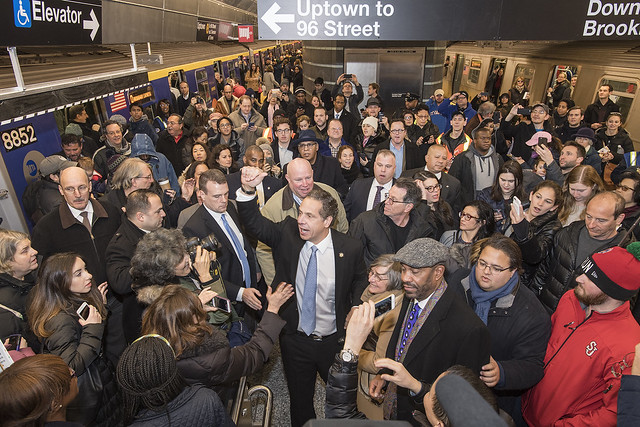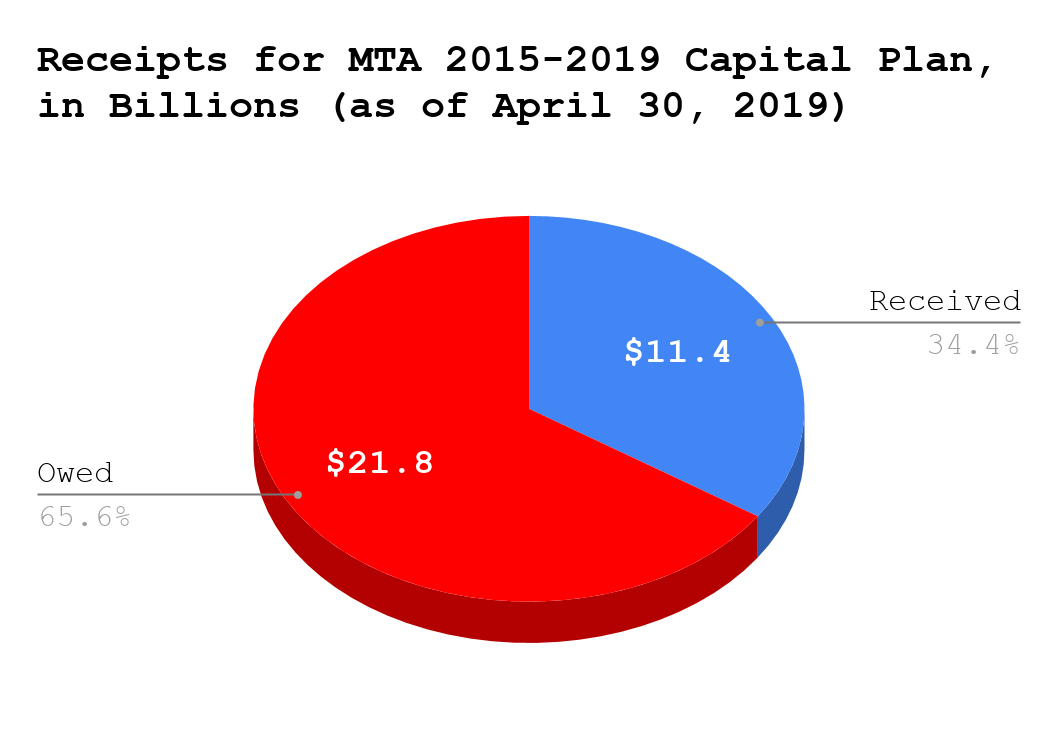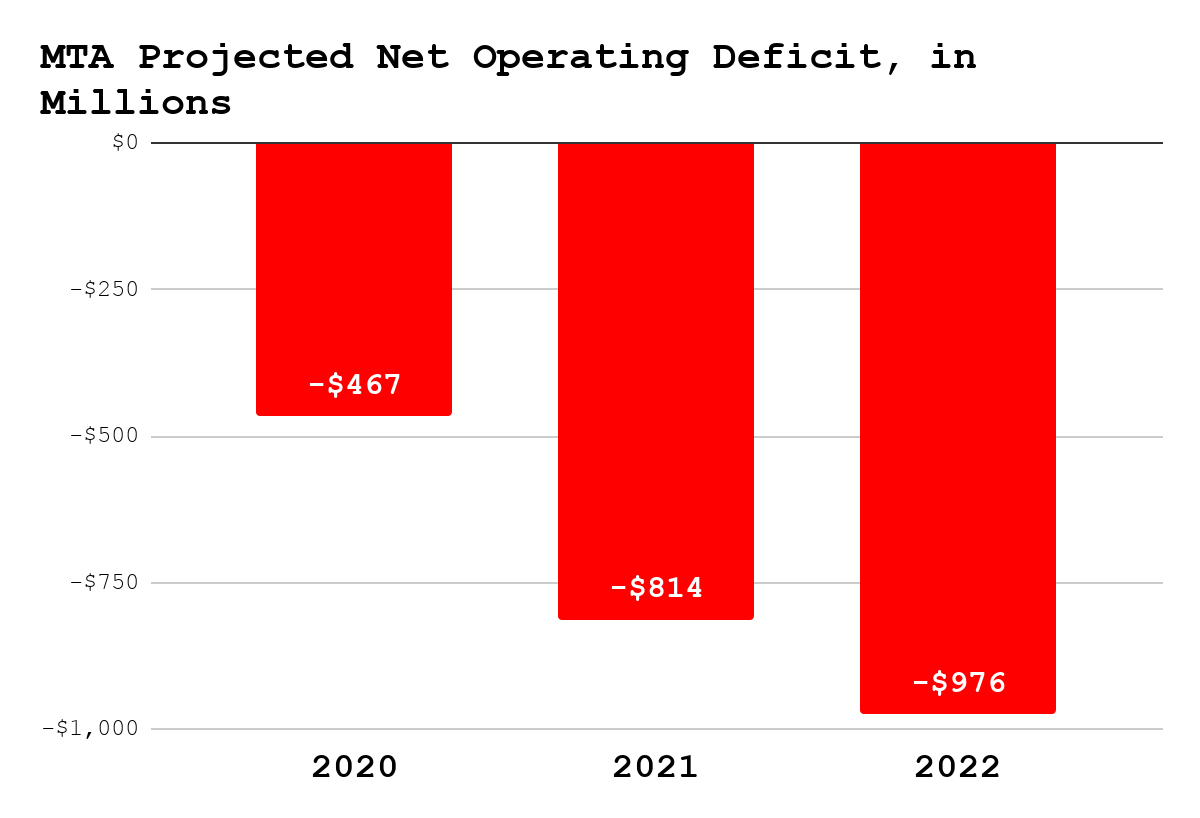
(photo: MTA/Patrick Cashin)
We call it the distraction circus. Donald Trump’s advisor, Steve Bannon, called it “flooding the zone with sh*t” to befuddle the news media and critics. Whatever you call it, the endless kerfuffle Governor Cuomo is stirring around the Metropolitan Transportation Authority (MTA) is obscuring what we think are the MTA’s potentially catastrophic money problems.
Yes, even after new revenue from congestion pricing is factored in, the MTA is still in big financial trouble.
Five very big things jump out in terms of the MTA’s fiscal health. First, Governor Cuomo and legislative leaders are sending strong signals they are going to renege on the remaining $7.3 billion they promised the MTA in direct state aid in the 2016 state budget for the 2015-2019 MTA capital plan. Second, the governor says state monies will generate only about $30 billion of the $40 billion to $60 billion his own workgroup estimated the MTA needs for its 2020-2024 capital plan.
Third, the governor is strongly suggesting the MTA will have to borrow roughly $10 billion to $30 billion on top of its already soaring debt load. Fourth, even with massive cost cutting, the MTA’s debt payments are rising to alarming levels, with 19% of operating income possibly going to debt by 2022, raising the harbinger of a “death spiral.”
Fifth, these are not the MTA issues the Board, Legislature, or transit reporters are talking about nearly enough.
Importantly, the MTA is facing these dire fiscal pressures while New York City’s economy is in the midst of a decade-long boom and state and city tax revenues are at record levels. What happens when there is the inevitable downturn?
The MTA is Fiscally Exhausted, so Where is the $7.3B?
With much fanfare, the Governor and State Legislature included in the 2016 state budget a “historic” commitment of $8.3 billion in direct state aid to the MTA’s 2015-2019 capital plan. More than three years later, the state still owes the MTA $7.3 billion.
The devil is truly in the details for state budget promises. The much touted 2016 state bailout of the MTA allowed $1 billion to be given to the MTA without condition, but an additional $7.3 billion will only be available after the MTA borrows until it can borrow no more -- in other words, when the MTA is fiscally “exhausted.” (See Part NN of the 2016 budget.)
As of May 2019, the MTA has gotten only $1 billion of the state bailout money promised in 2016, and $11 billion from all sources for the $33 billion it planned to spend on the 2015-2019 capital plan.
The Subway Action Plan: A Distraction from the $7.3B owed by the State?
As of December 2017, the MTA had received only $65 million of the state capital dollars promised in the April 2016 state budget for its 2015-2019 capital plan. In July 2017, the governor announced the Subway Action Plan, which included $328 million for capital projects (which is less than 5% of the $7.3 billion of the promised state capital funds). Yet, the Subway Action Plan has become a proxy for effort by the state. The governor’s office has repeatedly emphasized the millions the state was contributing to the Subway Action Plan while glossing over the $7.3 billion it owes the MTA.
[READ: There's Plenty of Money in the MTA Capital Plan, It's Just Not Being Spent]
MTA Tens of Billions Short of Funding Needed for Capital Plan Starting in 2020
To recap, the state still owes the MTA $7.3 billion for the current, 2015-2019 capital plan. Now, the governor says the MTA won’t get new state funding for the next capital plan.
Last week, Governor Cuomo doubled down on his rhetoric that the MTA must “reform” or it won’t get more funding from the state for the MTA’s 2020-2024 capital plan. Speaking on The Brian Lehrer Show, the governor said that the MTA will get only $30 billion from the state for the MTA 2020-2024 capital plan, including congestion pricing and state dedicated taxes, saying it needs to do better with the billions it has. This is much less than the $40 billion to $60 billion Cuomo’s own MTA Sustainability Workgroup concluded in December 2018 would be needed for the 2020-2024 plan.
The biggest problem with this statement is that the MTA is already fiscally exhausted, and “reform” -- including possible consolidations from a forthcoming reorganization plan (more on that here) -- will not possibly make up the additional $10 to $30 billion that the MTA is missing to meet its needs for the next capital plan.
Skyrocketing Debt Payments: 19 Cents of Every Fare Dollar
While the MTA has been borrowing itself into a state of “fiscal exhaustion” to meet the terms of the 2016 state budget for its promised $7.3B, debt service payments have soared to record levels.
In 2017, debt payments cost 17% of the MTA’s operating budget. By 2o22, debt payments will consume 19% of the operating budget, as projected in its February 2019 financial plan. (All charts in this piece are sourced from data in this plan.)
In total, debt payments will be $3.22 billion in 2022 -- an increase of 27% since 2017.

And with a threat from the governor of no more state funding, the MTA seems to be on the path toward even more borrowing if it is to even attempt to meet its capital needs for 2020-2024.
Blunt Cuts Won’t Save the MTA
With debt service on the rise and ridership declining, the MTA is facing a large operating deficit. The operating budget pays for everyday subway, bus, and rail service, and money borrowed to pay for capital expenses. Every dollar paying back borrowed money is a dollar that cannot be spent on subway or bus service.
As debt costs soar, so does the ongoing gap between the MTA’s income and expenses. The MTA’s deficit for 2020 has now reached $467 million, with even larger gaps in the years to come. (To be sure, the MTA is also struggling with costs including health care for current and retired workers -- a problem for many big employers in the U.S.)

If the MTA can’t reduce its debt payments, how can it make up future operating losses? The biggest likelihood is through workforce reductions, which could increase the risk of entering a “death spiral” of less service, fewer riders, and less farebox revenue. Labor makes up 60% of operating costs and the MTA’s labor contracts are up for renewal this year. The MTA has 75,000 employees and is by far the largest unit of state government.
There are rumors of big layoffs circulating within the MTA. The obvious concern for riders is how layoffs affect customer service. A smart reorganization of the MTA could make sensible consolidations, but there is tremendous pressure to close the MTA’s operating deficit and chop out dead wood. The risk is the reorganization could decimate the MTA’s workforce at a time when working for the MTA is not likely at the top of job seekers’ lists, all while the governor continues to harshly criticize the MTA professional staff for lack of innovation and execution.
Exhausted and in Danger
In the 2016 budget, the governor and Legislature committed $8.3 billion to the MTA. They have given it $1 billion. Will the MTA get the remaining $7.3 billion? Will the governor and Legislative Leaders finally level with the public? Where the heck is the MTA supposed to find the roughly $50 billion it needs for the 2020-2024 rebuilding plan? How much money does the MTA really need? What is the debt redline? Some states keep debt payments at 5% to 7% of their operating budgets, while the MTA is edging towards an astronomical 19%. The danger signs for the MTA are mounting, and we need an honest discussion of how to fix this problem before it’s too late.
[READ: There's Plenty of Money in the MTA Capital Plan, It's Just Not Being Spent]
***
Rachael Fauss is Senior Research Analyst and John Kaehny is Executive Director at Reinvent Albany. On Twitter @ReinventAlbany.
***
Have an op-ed idea or submission for Gotham Gazette? Email This email address is being protected from spambots. You need JavaScript enabled to view it.




